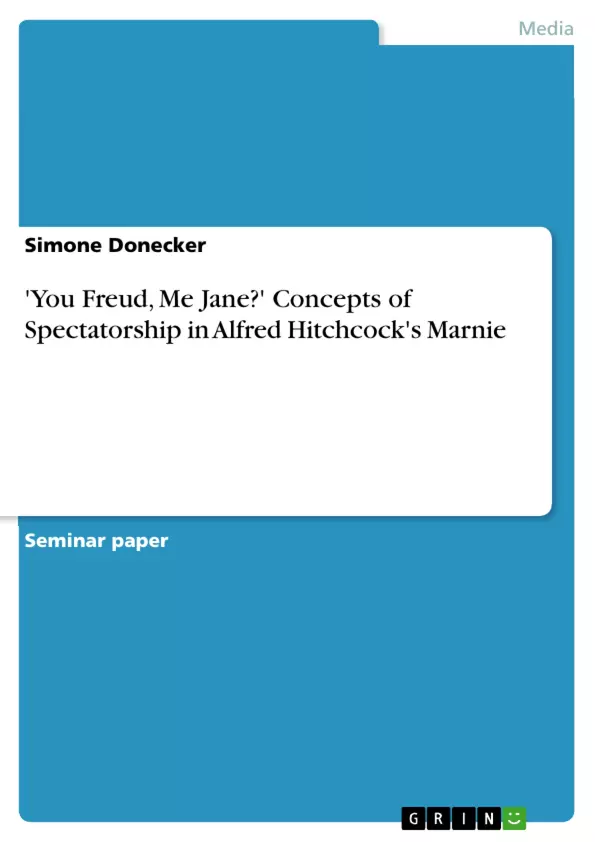Men act and women appear. Men look at women. Women watch themselves being looked at. In the history of cinema Hitchcock appears as one who no longer conceives of the constitution of a film as a function of two termsthe director and the film to be made - but as a function of three: the director, the film and the public which must come into the film, or whose reactions must form an integrating part of the film. The interest of visual narrative in Alfred Hitchcock’s movies is well-documented and widely-known. His films provide a context for the analyses of spectatorship which examine the theories, structures, and functions of the gaze. Furthermore, by letting the spectator negotiating and producing the film’s meaning, Hitchcock’s works acknowledge the presence of the audience. His film’s calculated narrative style, the self-consciousness within his works, and the address of the spectator make his movies a prolific source for the examination of different approaches to the media viewer. In film theory, Hitchcock’s concentration on the male character and the male gaze represents a specific and often problematic debate. In my paper I will examine some of the theories that shaped the discourse of identifying and positioning the spectator within the narrative of film by focusing on Alfred Hitchcock’s filmMarnie(1964), since this movie is probably Hitchcock's most significant work to visualize the subjective psychological states of his problematic central character through the use of cinematic technique. First, I want to focus on a psychoanalytical interpretation by explaining the dynamics that Laura Mulvey describes in her analysis of conventional narrative films in the ‘classical’ Hollywood tradition that not only typically focus on a male protagonist in the narrative, but that also assume a male spectator. Theories that work within this tradition have cited Hitchcock as a director exemplary of the Freudian or Lacanian exegesis. By the 1980s Mulvey’s theory generated considerable controversy amongst film theorists and was criticized to present an oversimplification of Hitchcock’s agenda. Since then scholars shifted their interest to a strong empiric or historic focus on the spectator. The collapse of the psychoanalytic interpretation was replaced by heavily contextualized analyses that questioned universalizing categories. [...]
Inhaltsverzeichnis (Table of Contents)
- Concepts of Spectatorship in Alfred Hitchcock's Marnie
- Psychoanalytic Interpretation
- Visual Pleasure and Narrative Cinema
- The Male Gaze and Voyeurism
- The Mirror Stage and Narcissism
- Reception Studies
- The Active Spectator
- Beyond Psychoanalysis
- Research Model
Zielsetzung und Themenschwerpunkte (Objectives and Key Themes)
This paper examines the concepts of spectatorship in Alfred Hitchcock's film Marnie (1964) by analyzing various theoretical approaches. The paper focuses on how the film's narrative and cinematic techniques engage the spectator and the role of the male gaze in shaping the viewer's experience.
- The Male Gaze in Film
- Psychoanalytic Theories of Spectatorship
- Reception Studies and the Active Spectator
- Cinematic Techniques and the Creation of Meaning
- The Role of the Female Character in Film
Zusammenfassung der Kapitel (Chapter Summaries)
- Concepts of Spectatorship in Alfred Hitchcock's Marnie: This introductory chapter provides an overview of the paper's objectives and the importance of Hitchcock's films for the study of spectatorship.
- Psychoanalytic Interpretation: This chapter examines Laura Mulvey's psychoanalytic interpretation of classical Hollywood cinema, focusing on her concepts of the male gaze, voyeurism, and narcissism. The chapter explores how Mulvey's theory applies to Hitchcock's Marnie.
- Reception Studies: This chapter contrasts Mulvey's psychoanalytic approach with Janet Staiger's reception studies, highlighting the role of the active spectator in constructing meaning. The chapter discusses the limitations of Mulvey's theory and how Staiger's approach offers a more nuanced understanding of spectatorship.
Schlüsselwörter (Keywords)
This paper explores the concepts of spectatorship, the male gaze, psychoanalytic theory, reception studies, Alfred Hitchcock, Marnie, visual pleasure, voyeurism, narcissism, cinematic techniques, and narrative structure.
- Quote paper
- Simone Donecker (Author), 2005, 'You Freud, Me Jane?' Concepts of Spectatorship in Alfred Hitchcock's Marnie, Munich, GRIN Verlag, https://www.grin.com/document/61326




